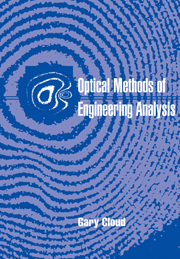Book contents
- Frontmatter
- Contents
- Acknowledgments
- 1 Introduction and orientation
- Part I Optics and interferometry
- Part II Photoelasticity
- Part III Geometrical moire
- 7 Geometrical moire theory
- 8 In-plane motion and strain measurement
- 9 Moire mapping of slope, contour, and displacement
- Part IV Diffraction theory, optical processing, and moire
- Part V Moire interferometry
- Part VI Holographic interferometry
- Part VII Speckle methods
- Author index
- Subject index
8 - In-plane motion and strain measurement
Published online by Cambridge University Press: 12 January 2010
- Frontmatter
- Contents
- Acknowledgments
- 1 Introduction and orientation
- Part I Optics and interferometry
- Part II Photoelasticity
- Part III Geometrical moire
- 7 Geometrical moire theory
- 8 In-plane motion and strain measurement
- 9 Moire mapping of slope, contour, and displacement
- Part IV Diffraction theory, optical processing, and moire
- Part V Moire interferometry
- Part VI Holographic interferometry
- Part VII Speckle methods
- Author index
- Subject index
Summary
This chapter describes some practical applications of geometric moire analysis in the measurement of displacement, deformation, and strain. Questions of sensitivity, some extensions of the method, and laboratory details are also discussed.
Determination of rigid-body motion
The moire phenomenon has been used, but not extensively, to sense the rigid-body rotations and translations of objects relative to a fixed coordinate system or to another object. The devices can give visual readout or serve as a source of an electronic signal that can be used in feedback control. As an illustrative application, consider the problem of developing a simple method for precise angular positioning of a shaft over a small range of motion. The apparatus must have low mass, be portable, and give visual readout. Application possibilities are automatic or manual control of a steering mechanism, directional control of an antenna, measurement of wind direction, and so on.
One way to accomplish the desired result is to utilize two rigid moire grills.
One of the grills is attached to the end of the shaft. The other is placed in close proximity to the first, but rigidly fixed. Figure 8.1 illustrates the general scheme. The two grills are initially aligned so that no moire fringes can be seen. Then, by simply counting the fringes as they form, one can determine N at a given distance y from the shaft center; θ is calculated by equation 7.8. In practical terms, the goal is to establish θ as a function of fringe spacing or the number of fringes that move through a chosen point on the plate. Keep in mind that equation 7.8 is restricted to small θ.
- Type
- Chapter
- Information
- Optical Methods of Engineering Analysis , pp. 155 - 178Publisher: Cambridge University PressPrint publication year: 1995

